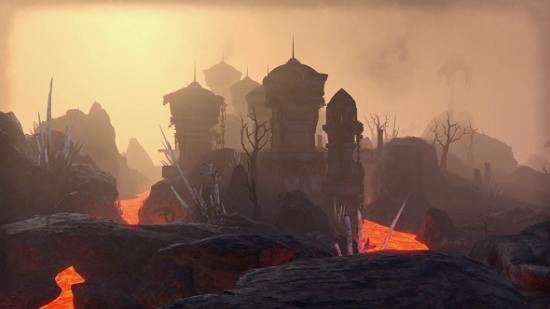I generally take a critical distance from trailers, and have an explicit aversion to those battle-focused CGI ones that always seem to accompany high-fantasy RPGs like Dragon Age: Origins, Skyrim, and, a couple of weeks ago, Elder Scrolls Online: Morrowind. Not only do I find them egregiously unrepresentative of the actual games, but there’s something about the ease with which the omnipotent on-screen characters kick ass and cast magic that seems a little adolescent, a little unmagical, as if casting spells were as simple as pulling the trigger on a paintball gun.
Read more: the best MMOs on PC.
But the gameplay trailer I saw at an event for ESO: Morrowind was another story. It starts with the camera slowly moving forward along that little pier in Seyda Neen, where so many of us took our first tentative steps in Elder Scrolls III all those years ago. Then it sweeps through gloriously remodelled versions of stunning in-game locations – a bustling Balmora, the strange carapace-township of Gnisis, giant mushrooms aplenty, and a partially built Vivec City (hopefully it won’t be such a nightmare to navigate this time). I’m barely looking at the PvE MMO action taking place in the foreground, or the new Warden class strutting around with his bear, which is supposed to be a big deal. For me, the trailer was a heavy nostalgia trip, capped off by a teasing few seconds of that blissful Morrowind theme tune.
The tune was the final straw. The bastard MMO got its hooks into me.
As you can tell, I’m fond of Morrowind. I recently spent hours modding the game to kingdom come, and what started out as a ‘modding for modding’s sake’ type project led to me being pulled into its world of towering fungi, dust storms, slavery, over-persistent cliff racers, and hypnotic, harsh landscapes. Now that my lengthy love affairs with Oblivion and Skyrim are over and my mind has cleared, I’m ready to declare that the topography and narratives of Morrowind were far more fascinating than those of its successors.
That ESO trailer did its job, suggesting that the devs are at least aware of the special place Morrowind holds in gamers’ hearts. But catering to that fondness throughout the latest chapter in Elder Scrolls Online is a much bigger task than exploiting it in a trailer (it was, in fairness, a well-edited trailer). I chat with Rich Lambert, the game’s creative director, about how ZeniMax Online Studios plan to make their recreation of Morrowind a worthy one.
“Something we learned soon after starting ESO is that Elder Scrolls fans are very vocal about lore and things that they love,” he says. “They love Morrowind, and we had to make sure to give the a true representation of the place.” To that end, the devs took the unusual step of using the exact same map as the original Morrowind for ESO, albeit stretched and squished in all the necessary places to fit into the more modern ESO world.
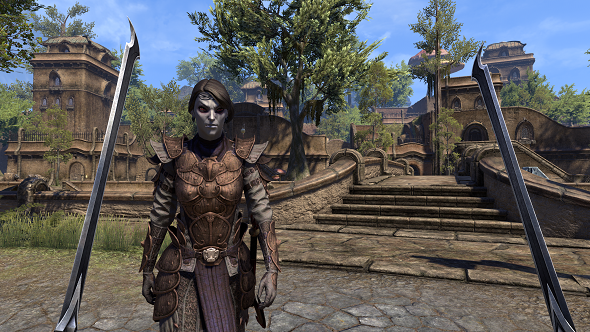
From GTA to Zelda, videogame series love to reimagine and overhaul familiar locations across multiple titles – so you’ll never see the same Los Santos or Hyrule twice. But Elder Scrolls’ world is more rigid than that. Maps of Tamriel have existed since the Daggerfall days (1996 but who’s counting?), and fans have become far too invested in the geo-political lay of the land to take kindly to any drastic changes. Even if you’re not an Elder Scrolls lore-diver, for many of us Morrowind (or more specifically Vvardenfell, the isle where most of the action takes place) played a monumental role in our gaming lives as it was one of the first times we got to experience a truly open and believable 3D world. Few people forget their adventures in Morrowind; the place is so tangible and significant that it’s practically a holy site of gaming, and may the Nine have mercy on those who dare try to desecrate it.
Despite being set 700 years before Elder Scrolls III, ESO’s faithful recreation of Vvardenfell is clearly designed to make us Morrowindians feel right at home. The land is still (or ‘already’, depending on how you look at it) divvied up between the five Great Houses of the Dunmer, who exist in a kind of Cold War harmony while using the Morag Tong assassins to quickly silence any upstarts and destabilising parties in the region. On the spiritual level, the hermaphroditic mortal god Vivec oversees things from his Mayan-like palace in the middle of his eponymous city, and barbaric ashlanders inhabit camps in the wilderness.
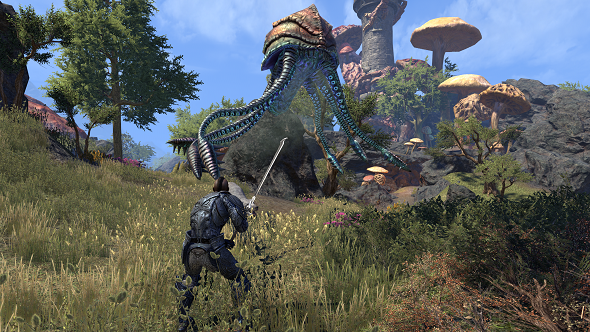
And speaking of wilderness, you’ll find many of the same strange, shelly creatures roaming the lands. The goofy kagoutis and sinister brain-sucking hungers are back, and silt striders have already been tamed in this timeline to provide a means of fast travel. Those surreal flying squids are accounted for too, but one crucial detail hasn’t been mentioned. I ask about the dreaded cliff racers, the spammy, persistent pterodactyl-like creatures that borderline-ruined many an ESIII player’s days (check out this video of a mod that spawns two for every one you kill for some sardonic amusement). Lambert chuckles when I reminisce about cliff racers. “We didn’t want streams and streams of pterodactyls attacking people. We’ve changed them to cliff striders now.” I’m sure that won’t be a deal-breaker for too many people…
It’s not just the heavyweight world-building that’s there to welcome old-timers, but irreverent nods too. Everyone who played Morrowind remembers the Census and Excise Office where you create a character by speaking with eccentric immigration agent Socucius Ergalla (“Ahhhh yes. We’ve been expecting you…”). In ESO, a quest takes you to the very same building, where a distant ancestor of Ergalla’s (identifiable by the surname) starts asking you about your background, before being told by a guard that you’re not fresh off the boat. It’s a nice little touch that’ll force a fond smile even on the face of the cynic who sees all of ESO as a bastardisation of the Elder Scrolls name.
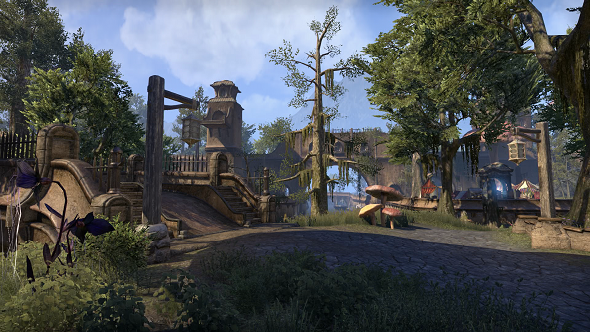
So ESO: Morrowind is faithful to its roots. Very faithful. But once this point was hammered home I was intrigued to know the details about but what’s changed in my beloved Vvardenfell in those 700 years. Quite a lot, according to Lambert: “Vivec City is still under construction, and Ghost Gate isn’t there because the volcano hasn’t erupted yet. This also means the biomes are different, so the Ashlands are a little bit smaller, and Balmora, which was arid in ESIII, is lush and green here.” It seems that all such changes in the game are based on historical and geographical phenomena within the world, rather than things that inexplicably happen just for the sake of updating the design. It imbues exploration in ESO: Morrowind with a layer of genuine historical curiosity.
One of the more compelling details that I spoke with Lambert about was the meteor precariously hovering above Vivec City, suspended in the air as an ostentatious show of power by Vivec himself (the big diva). Where in Elder Scrolls III it housed a prison running on slave labour, in ESO it’s uninhabited, but inching closer and closer towards the ground due to Vivec being sick and unable to support it. Naturally, then, you get drawn into a quest where you need to help him. Another intriguing quest sees you trying to free an Argonian slave with dreams of becoming a Telvanni mage, bringing you into contact with the slavery that’s an accepted part of society in this region. “Morrowind has always been filled with dark themes, and we want players to see them,” Lambert assures me. It’s good to know that the unique, otherworldly, and often dark spirit of Morrowind isn’t being diluted for its online rendition.
Such quests are in line with the game’s recent form; the devs have been working hard on making the world feel more alive and involved than how those who played ESO in its early days may remember it. There’s something poetic about a return to one of the most loved locales in the series also marking ESO hitting its stride after what the developers themselves admit were shaky beginnings.
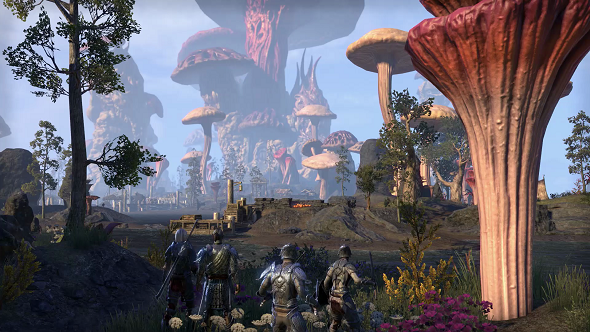
Morrowind is a place many of us associate with getting lost in the wilderness, of taking a wrong turn in some stretch of ashland or swamp and stumbling upon a tomb or NPC that leads us onto unexpected adventures. This was largely thanks to the game’s charmingly rustic approach to navigation, forcing us to follow road signs, directions scribbled into our journals, or simply word-of-mouth directions from NPCs. While it’d be unrealistic to expect a modern MMO to leave players quite so untended, Lambert said that he wanted to channel some of that feeling into ESO:
“What captured my attention about Morrowind when I first played it was that it was so freeform, letting you go anywhere, and even got lost if you wanted to,” he says. “I want ESO players to get that same kind of feeling. There are many places off the beaten path here that we don’t direct you to at all – you’ll just have to go find them.”
Perhaps the most crucial thing here is not so much that ESO’s take on Morrowind is faithful to ESIII, but that it continues on the path to bringing this online game closer in spirit to the sprawling, undirected and free-feeling mainline games that made the series one of the most loved in video-games. There’s no place more fitting than Vvardenfell to showcase how far ESO has come towards rediscovering its lineage.
